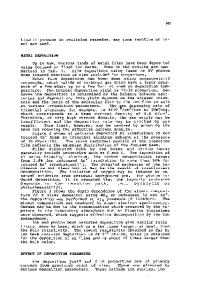Ion Beam Deposition of Boron-Aluminum Nitride Thin Films
- PDF / 341,127 Bytes
- 6 Pages / 414.72 x 648 pts Page_size
- 14 Downloads / 334 Views
J.H. EDGAR+, C.R. EDDY, JR.*, J.A. SPRAGUE* and B.D. SARTWELL** +Department of Chemical Engineering, Kansas State University, Manhattan, KS 66506-5102 *Code 6671, Naval Research Laboratory, Washington, DC 20375-5345 **Code 6170, Navel Research Laboratory, Washington, DC 20375-5342
ABSTRACT Analysis of the phase behavior, structure, and composition of aluminum nitride thin films with up to 22% boron prepared by ion-beam assisted deposition is presented. The c-lattice constant of the film decreased with increasing boron content as expected from the formation of an AIN - wurtzite BN alloy. There was no evidence for separate boron nitride precipitation from either X-ray diffraction or FTIR. In contrast, Auger electron spectroscopy of the boron present in the films suggested that two types of boron bonding was present. INTRODUCTION The group III nitrides have come under increasing scrutiny in the past seven years for their potential applications as wide band gap semiconductors for high power-high frequency electronics and short wavelength optoelectronics.1- 3 A practical advantage of the group III nitrides is their formation of a continuous range of psuedobinary alloys, at least among AIN, GaN, and InN. Even greater control of the lattice constants and energy band gap of the group III nitrides could be achieved if the alloying capability also included solid solutions with boron nitride (BN). There are considerable structural and bonding differences between boron nitride and the other group III alloys suggesting that the boron solubility would be limited. Previous studies of BN-A1N and BN-GaN solubility have been ambiguous. Lyutaya and Bartnitskaya 4 prepared nonstoichiometric (mole fraction B, Al, Ga greater than the N mole fraction) compounds, speculating that the boron substitutes on both Al or Ga and N positions. The B-Al-N thin films prepared by Noreika and Francombe 5 by reactive sputtering had smaller lattice constants than pure AIN, which the authors suggest might be5 caused by B substitution on Al sites or from the formation of aluminum-boron compounds. In this paper, the results on the solubility of boron in aluminum nitride thin films prepared by ion-beam assisted deposition (IBAD) are reported. The film's composition and structure were analyzed by Auger electron spectroscopy (AES) and x-ray diffraction, respectively. Fourier transform infrared (FTIR) spectroscopy of the films was taken to provide insights into the localized structure of the bonds, and to determine if BN precipitates form. EXPERIMENTAL The BAIN films were prepared by IBAD from electron beam evaporated boron and aluminum, and nitrogen ions supplied from a Kaufman ion source. Silicon (111), both on-axis and 1 to 2 degrees off-axis, were used as substrates. The Al evaporation rate, as detected by quartz crystal monitors, was held constant at 2.2 A/second, and the B evaporation rate was adjusted to achieve the desired composition. Two nitrogen beam energies were employed, 100 and 200 V, with depositions at two substrate temperatures, 600 and 675
Data Loading...











